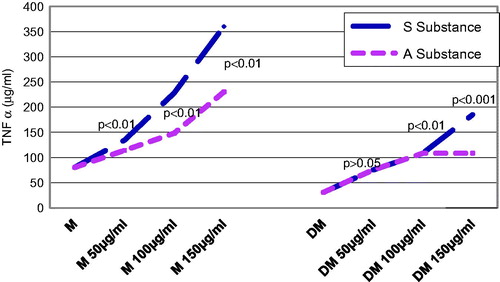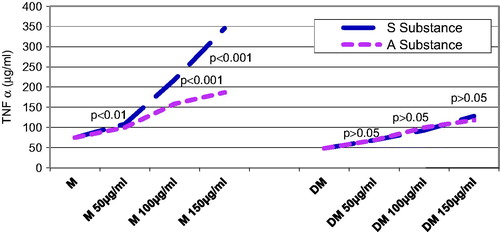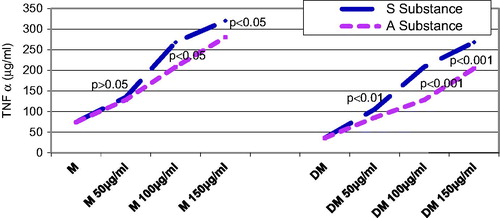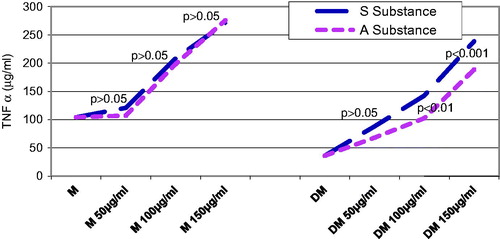Figures & data
Figure 1. Influence of substances S and A on TNF-α secretion 24 h after administration: in the diabetic groups compared with controls were found significantly lower average TNF-α values in groups receiving substance A (except for the dose of 50 mg/mL (p < 0.05), or substance S regardless of the concentration (p < 0.01 at a concentration of 50 mg/mL and p < 0.001 at a concentration 100 mg/mL). Diabetic rats receiving in 24 h substance A or S at a concentration of 150 mg/mL caused a significant increase in TNF-α as compared with the diabetic rats who had not received either A or S (p < 0.01). In diabetic rats, the same concentrations of solutions A and S did not result in significant differences (p < 0.05).

Figure 2. Influence of substances S and A on TNF-α secretion 48 h after administration: 48 h after administration, both control and diabetic rats have shown a significant increase in a dose-dependent secretion of TNF-α for both substances. Average values of TNF-α were significantly lower in diabetics compared with controls, regardless of the concentration or substance administered (p < 0.01 at a concentration of 50 mg/mL and p < 0.001 over 100 mg/mL).

Figure 3. Influence of substances S and A on TNF-α secretion 72 h after administration: the level of TNF-α after 72 h from the administration of both substances, both in control groups and in diabetic groups, it is about the same values and the same characteristics as those recorded at 24 h after administration.

Figure 4. Influence of substances S and A on IFN-γ secretion 24 h after administration: diabetic group receiving at 24 h, either substance S or substance A, in a concentration of at least 100 mg/mL had a significant increase in secretion of IFN-γ compared with the diabetic group to which these substances have not been administered (p < 0.05). At the same concentration, A and S have shown significant differences (S > A) if administered with a concentration of at least 100 mg/mL (p < 0.05).

Figure 5. Influence of substances S and A on IFN-γ secretion 48 h after administration: in diabetic rats after 48 h of taking at least 50 mg/mL of substance S, the secretion of IFN-γ has increased significantly in comparison with the untreated diabetic rats (p < 0.01); the same phenomenon is observed with the administration of A substance as well, but the serum level of IFN-γ was lower than in the case of the administration of substance S regardless of the dose.

Figure 6. Influence of substances S and A on IFN-γ secretion 72 h after administration: the diabetic group who received at least 00mL of either S or A substance, compared with the untreated diabetic group, was evidenced a significant increase in IFN-γ (p < 0.001); diabetic groups who received the same concentration of solution A or S did not differ statistically significant (p > 0.05).

